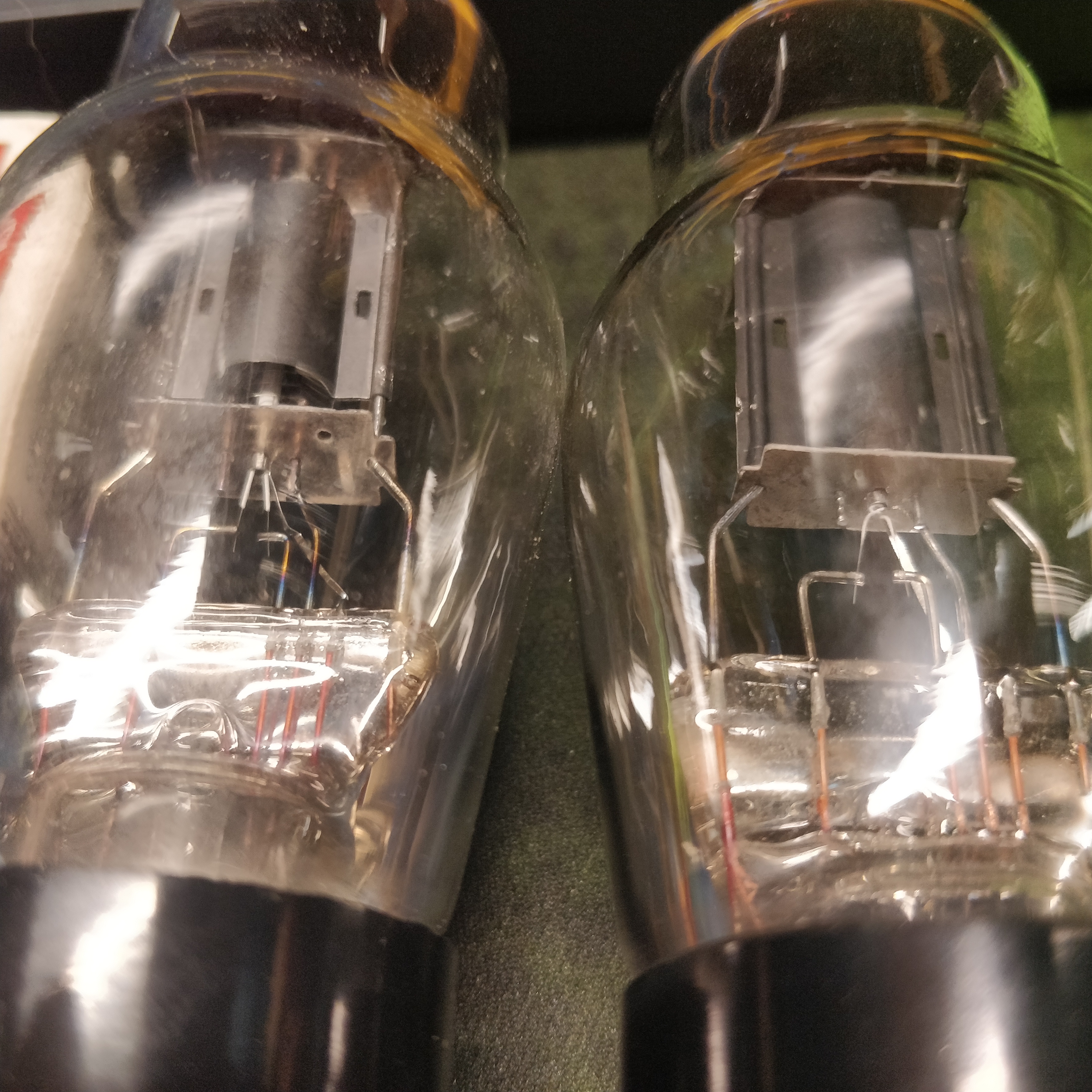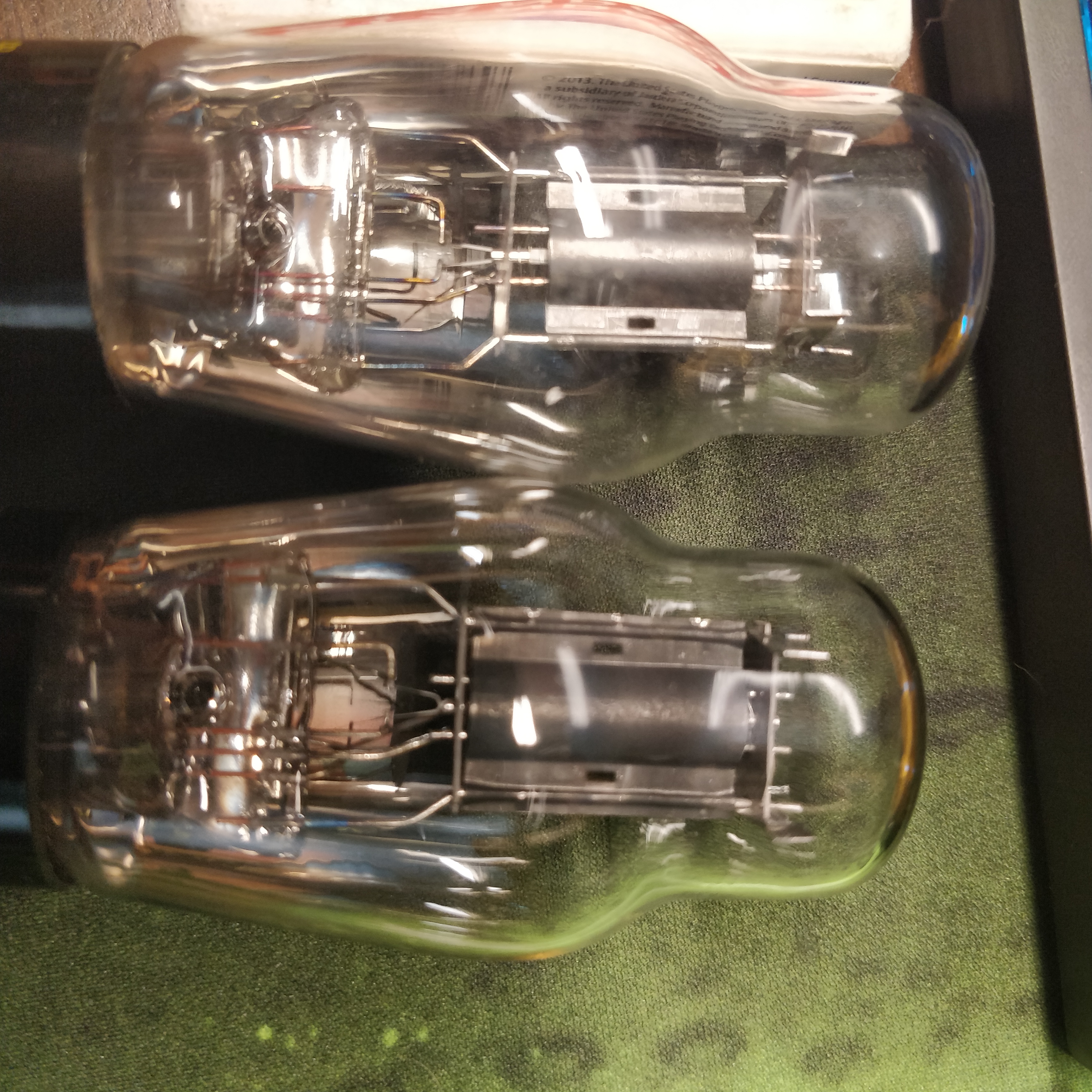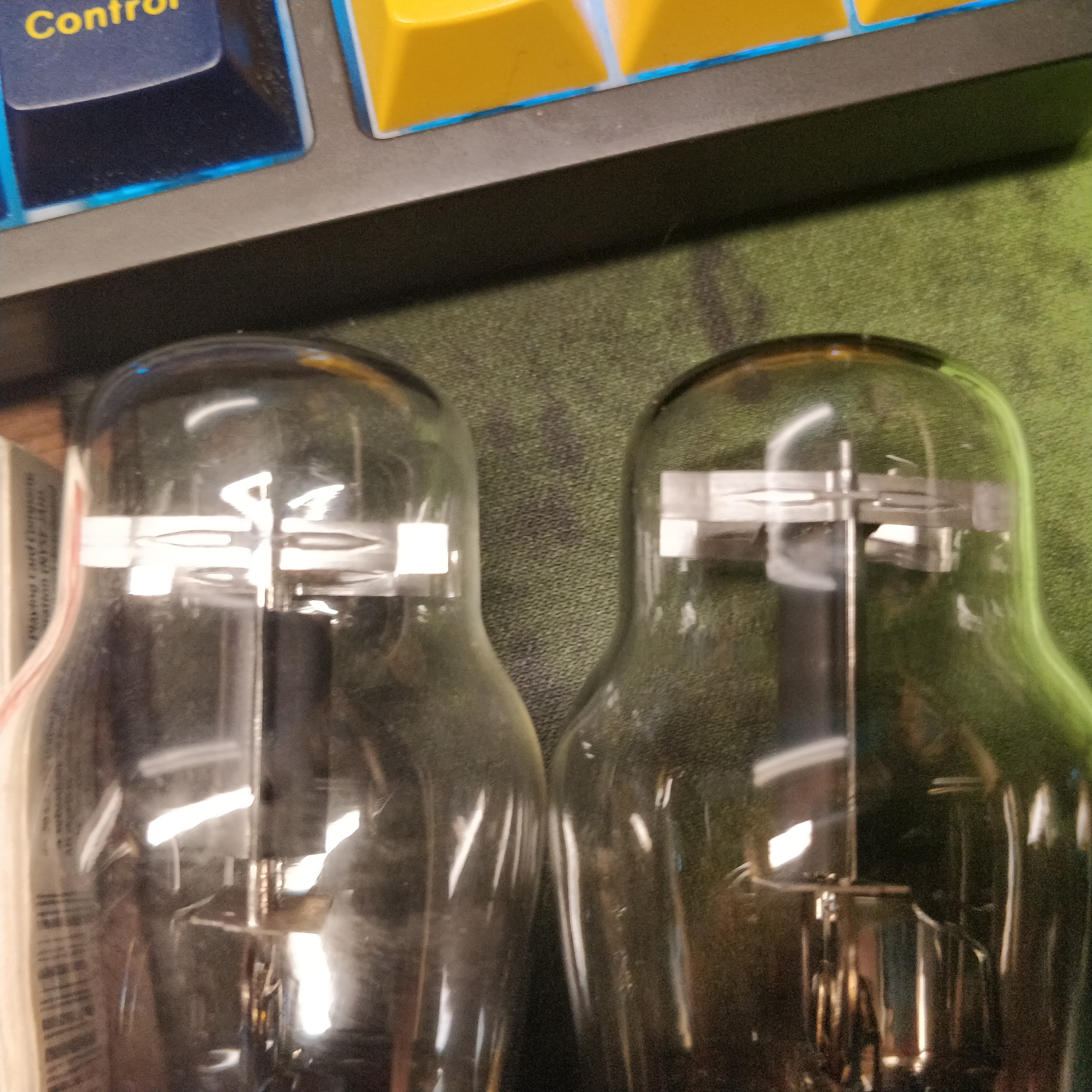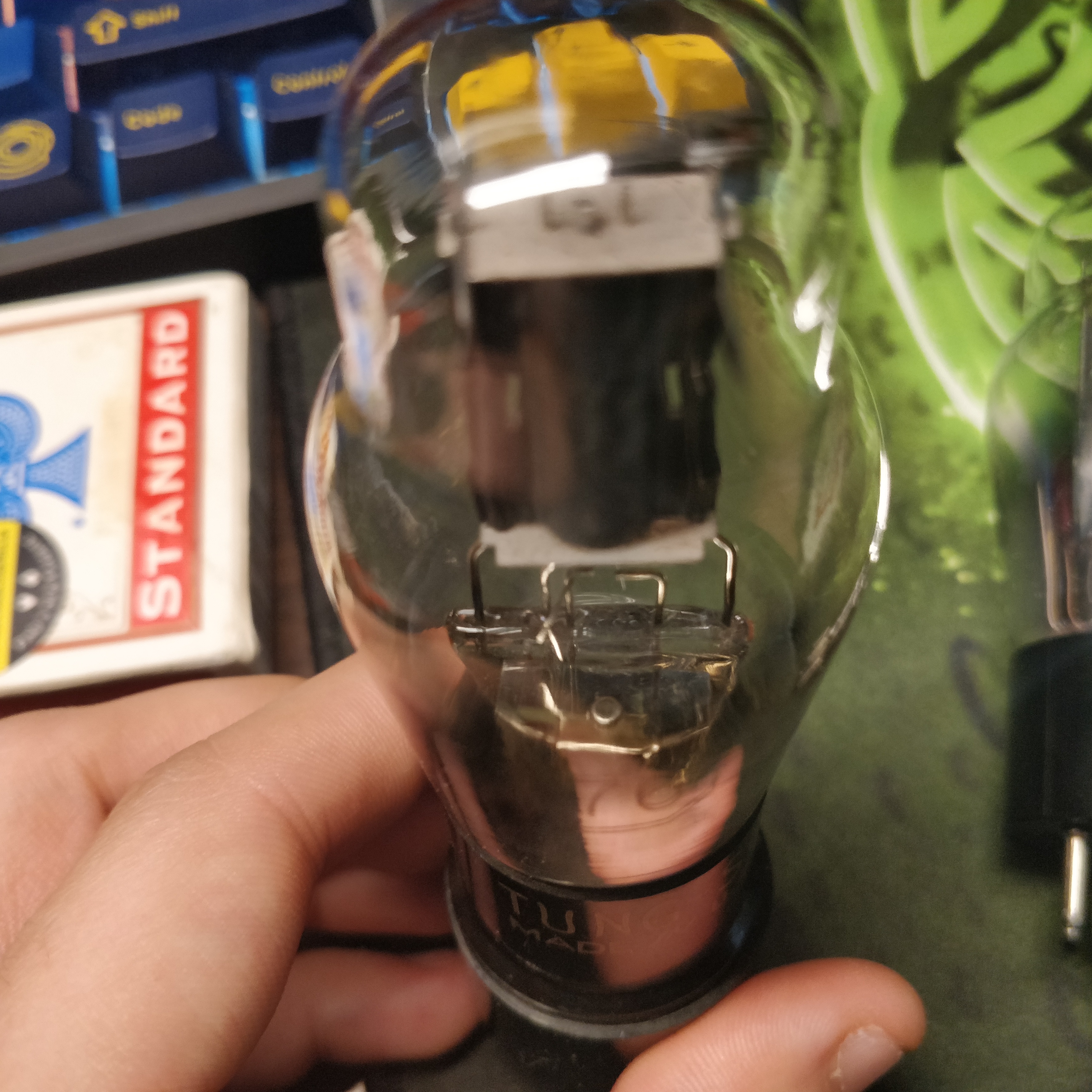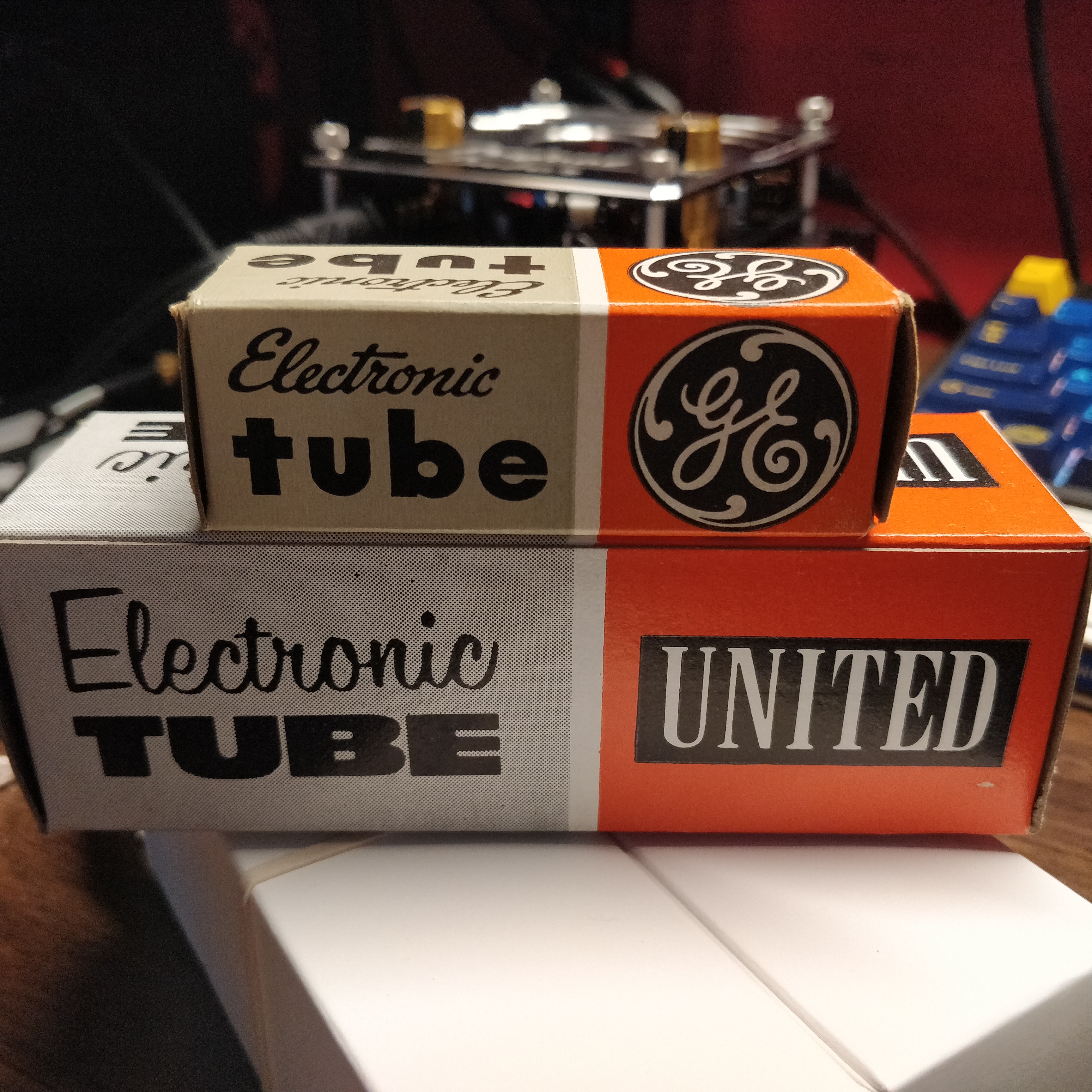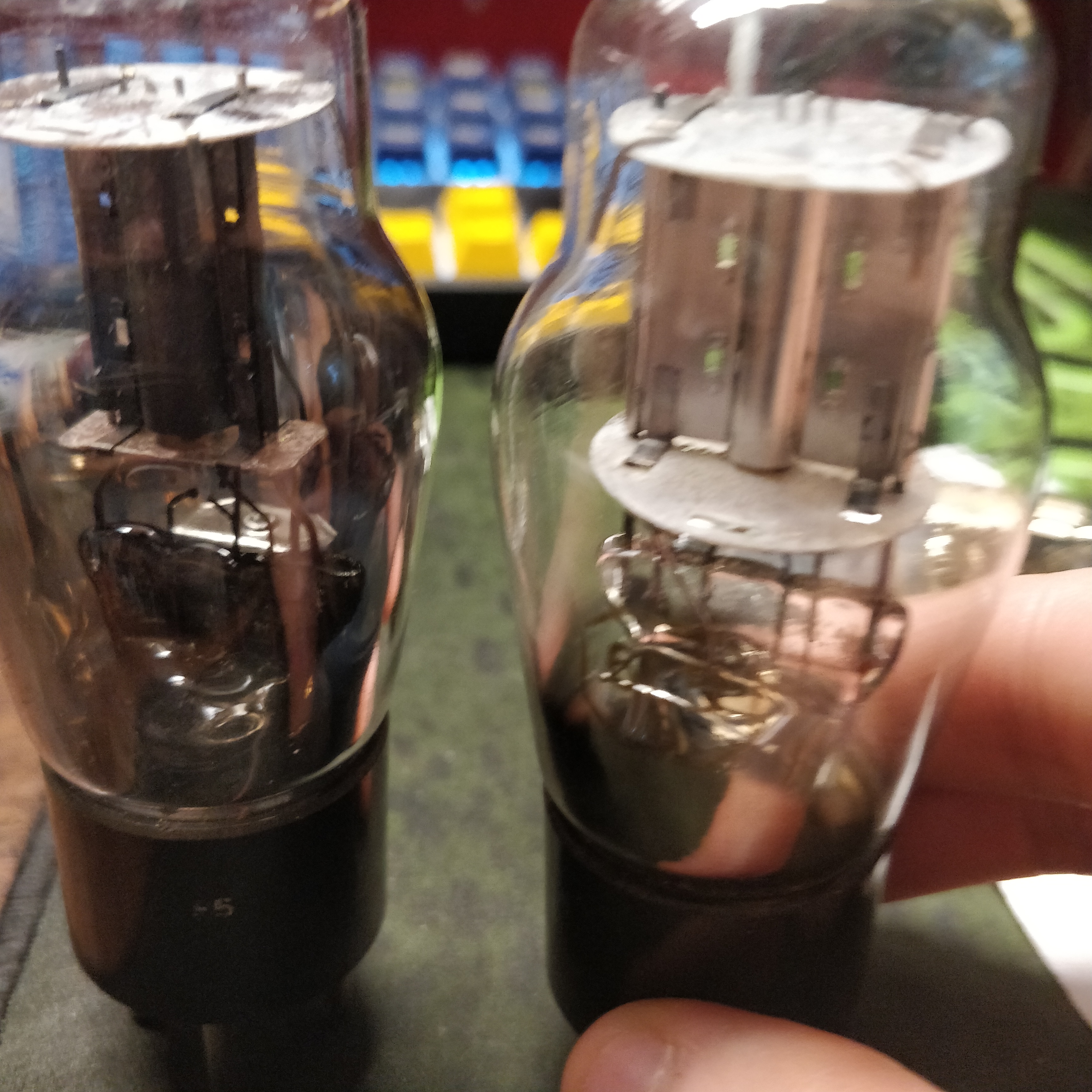Alright here we go. I am about to use my words to describe sounds. Strap yourselves in folks this is a longer one. We are covering 11 pairs of tubes here in hopefully as much detail as any of you could ever want.
Testing: PC-> USB -> Monolith THX 788 DAC+AMP (Dual AKM 4493) -> RCA Preout -> Garage 1217 Project Ember 2.1
Sources: Denon D9200 (24 ohm, TOTL flagship, bright, slightly u shaped character), HD 650 (you know what these are), Preout to Denon PMA 800NE (Warm tilted speaker amp) > SVS Ultra Bookshelf (Bright leaning, very detailed, SVS flagship bookshelf) + SVS SB 12NSD (subwoofer. wubwub)
I did 90% of my listening on my D9200’s and most of the impression are taken with these headphones.
All noisefloor impressions were done with my 24 ohm Denons.
The playlist that I was using is predominantly
this although I did use other music. It should be noted that I was searching out certain points in most of these songs or utilizing them for certain frequency ranges or instruments.
I let each tube warm up for about 3-5 minutes. Not ideal, but then again, most tubes normalize after like 60 seconds and I am trying to retain some memory of what things sound like. Because I cannot do direct tube comparisons, I used my Solid state as an intermediate step. Jumping back and forth between tube and solid state to compare the relative differences. I do have a good ear for tubes though and can pick out their relative characteristics fairly well at this point in my tube rolling journey.
Some disclaimers:
- I am in the tube game for tubes to do something to my music and to have tube qualities. I don't like incredibly clean or solidstate-like tubes. That is my bias.
- My amp is a 48V plate starved tube hybrid. It is not a cheap Chinese plate starved amp but still is plate starved. It is fairly tube revealing from my experineces but this is the only tube amp I have ever used. It may very well be that tubes in my amp sound different than tubes in a transformer'ed amp pushing 300+ volts. If anyone want's to send something with a transformer my way. I would gladly test all the tubes again.
- Average noisefloor is relative to all the tubes I have ever tried on my Ember. It is extremely crude and by no means scientific or precise methodology. I'm just using my ears and memory. The Ember is capable of running pretty much any 6v or 12v tube under 1A of heater current. So it encompasses a wide range of tubes. Below average is low noise, above average is high noise.
- "Tubey" refers to stereotypical tube characteristics like treble presentation, reduced harshness, softness, and warmth. Does not have to tick all the boxes, but does have to leave an impression of "tube" sound. Distinguishable from solid state refers to how similar to solid state clean, neutral, and dynamic they are. There is overlap between the two terms. Tube treble refers to a tubes tendency to reduce the FR, dynamics, and/or harshness of treble.
- Remember we are still dealing with audio here. I may make statements that make it sound like that a tube is completely changing a song. I want to address this upfront. Audio is weird. Psychoacoustics are weirder. Words are hard. Relativity and perspective are harder. If you have more than 1 pair of headphones you know what this is like. They can sound completely different, yet you are still dealing with the same source audio, and as different as it sounds, it sounds completely the same. Is that difference between your two headphones a 1% difference a 10% difference or a 40% difference? Realistically all 3 could be argued effectively. There is no objective way to categorize that when dealing with subjective listening. There is no relative frame of reference that is the same for everyone. I have no idea how to put that level of relativity and objectiveness into descriptions. I try, but just keep this all in-mind with the statements I am making. Driam all you want, but tubes are not going to turn your BL03 into an Orpheus.
Lets get started.
Zenith 6J5:
Technical Achievement Award
I can see why people like these tubes. They have great bass dynamics and overall retain much of the microdetail that is lost on other tubes. They are a very good technical performer, that being said, they were not ‘tubey’ more so they were really good at reproducing audio. Elevated bass slam and elevated vocal midrange this is done without necessarily sounding warm. Very neutral. Less than average tube treble. Very close to the detail and cleanliness of solidstate. It appears that these are made by Sylvania, they look nearly identical to my Sylvania 6J5 tubes, but they do not sound the same as my Sylvania 6J5's.
Zenith is in the rear Sylvania in the front. Very close to identical construction.
Not easily distinguishable from SS
Not Tubey
Average Noisefloor
United Electronic (Tung Sol?) 6L5:
Theremin Award
I am unsure who manufactures this tube. My best guess is Tung Sol. These are VERY similar to my Tung Sol 76 tubes. Same micas, same mica fins, same getters, and the rest of the construction is extremely similar.
From a bit of reading this seems like United Electronic is a tube rebranding brand.
Wonder who they are trying to emulate here...
The biggest standout thing about this tube is its noisefloor. This tube has a very noticeable 60Hz hum and it only gets worse the closer you are to it. Likewise if I ground myself on my Ember by touching the top of the caps, the screws, or the metal base the noise immediately goes away and it almost sounds like you become an electrical shield if you hold your hands over the tubes. A couple of tubes have this theremin effect but it is BAD on these tubes.
The best way I can think to mitigate this would be a faraday cage. Or possibly grounding the ember.
This may be in part due to how exposed the grid and cathode are as the plate only covers about 70% of the triode. [SPECULATION, no scientific backing to my statement]
So on to the actual audio characteristics. Wider than SS. Kills some of the upper mids and that presents a soundstage-like sound. Typical tube treble. Going back over to soildstate those two areas are immediately noticeable as the presentation seems to close in and clear up. Bass seems slightly elevated on the tubes as well. This may just be from that 60Hz hum though. Which does largely go away once you get music playing. It is still there if you go searching but I can largely ignore it.
The thing is these tubes don’t sound articulate or enjoyable. They are a bit sloppy and I want to say all over the place. It might just be my headphones and my gear, but I do not think these tubes sound all that great. Articulation and instrument separation are nowhere near what it is on other tubes. I am sacrificing quite a bit for tube sound, which I don’t think I need to do, other tubes have better characteristic tube sound while also sounding better at the same time.
Another interesting note is that the Tung Sol 6L5 that I received as detailed in the National Union 6L5 post looks completely different than both the United Electronic 6L5 and the Tung Sol 76. It looks closer to a RCA tube with a similar top mica design. The gentleman that I purchased these tubes from mentoined they were made by RCA but the reasoning that he gave was lackluster at best.
Last of the 3 images is the Tung Sol 6L5 compared to an RCA 76. Note the top mica similarities. I don't know of another brand to do top micas like this.
Moderately Tubey
Distinguishable from SS
Noisefloor is dependent on proximity to yourself and other electronics. At its quietest, noisefloor was below average. At its loudest, far above average.
Ken Rad 6C5G:
Fuzzy Wuzzy Award
The key thing that stands out to me with this tube is how ‘soft’ it sounds. It retains a good amount of detail but is lacking microdetail of solidstate.
It can almost be psychoacoustically confused with soundstage because it does make music sound ‘further away’ in the sense that microdeail is equally gone from all ranges creating a soundstage-like sound. Contrast with many tubes where it seems like a certain range has certain characteristics like loss of microdetail.
That being said on my 9200’s I don’t inherently perceive this as a bump in soundstage as I did the Marconi’s.
The best way I would describe these tubes is soft. Granted, once again to what degree is the hard part to describe. Enough to matter, not enough to overwhelm. Whatever that means. It feels like it retains a very good amount of solid state detail, but with smoother edges, music seems to flow and slur a bit more, but still keeps good instrument separation. The smoothing seems to take place within the instruments themselves rather than across the spectrum of music. Once again this is with Denon D9200’s and SVS Ultras. Expensive gear that already has good separation and clarity.
Dynamics are also a bit behind solidstate but I don’t know how much of that is the softness making me perceive a loss of dynamics due to less slam and fast decay and how much of that is actually lowered dynamics. The answer probably lies somewhere in the middle.
As far as FR characteristics go. Treble seems just a touch splashy with hi hats, snare drums, and cymbals. This feels bothersome to me. But I feel that this is subjective to both the person and the gear. I am not getting as much as a ‘tube treble’ feel with this tube as I do others. I do not like this tube for drum heavy music where that splashiness just tends to get to me a bit too much. Granted it is very subtle, and I believe halfly due to the other characteristics of this tube changing other bits of the music my perception of drums relative to everything else. It does really well though with vocal and lounge tracks and music that does not have heavy emphasis on drums, or the treble instruments are mastered so their levels are neutered significantly so they are not prominent in the music.
Changing over to the 650’s the softness is still there. This makes the 650’s very soft and very mellow. Meanwhile, the splashiness is a non factor with these. In fact treble seems more articulate although still very 650.
There might be some part of the midrange or upper bass with a slight lowering. No idea though. Might just be the general softness changing characteristics enough.
Easily distinguishable from SS
Tubey
Average noisefloor.
National Union 6L5G:
¯\_(ツ)_/¯ Award
This is a bit of a weird review. The seller that I bought these from messed up my order and sent over one Nat union tube and one Tung Sol. They are very different construction and they are not audibly identical. They are close enough, and the gain match is good so I still feel like I can glean some impressions out of my one Nat Union. I will post a better impression at the end of the month when the actual pair comes in.
Very technically impressive. It sounds very solid state outside of a softer treble. I would categorize this as strong tube treble in the sense that treble is softer than most tubes I have heard. Detail and articulation are fantastic everywhere else. But I would not consider this tube ‘tubey’. It really does not add much in the way of character. I’m really not getting ‘warmth’ or ‘darkness’ or ‘soundstage’ out of this tube. All I am getting is a softer treble. Which is by no means a bad thing. That’s kinda one of the things tubes do is soften treble. Maybe the bass is slightly elevated, but that could just be an effect of the softened treble. The softness does extend into the midrange, but is still very articulate.
Compared to my left ear Tung Sol, this tube retains more detail and is more articulate with better instrument separation. This might just be a gain difference.
I also wouldn’t trust this review too much until my actual pair comes in.
Hytron 6C5:
$1600 On Red Award
Originally I had a date matched pair of 6C5's but the glue on one of the metal bases was failing so the metal base was falling off and there was a gain imbalance on the tubes as well. But I knew that there was something special here. So I took a gamble on a single and it matches well enough.
These tubes are like skydiving. Fun and unlike anything else. But you best hope that everything works.
Both my replacement and my falling apart Hytron have times when they just freak out. If this happens, they get crazy staticky and cause some really loud crackling and popping in your ear. Both not great for your hearing and your $1000+ audio gear.
I am not sure exactly what causes this. Or why it goes away.
Sometimes it happens when turning it on, sometimes it is a buildup over time. Sometimes it goes away when I ground the base to the Ember's metal chassis. Sometimes it doesn’t. Sometimes it goes away when I touch the glass on the tube. My best guess is charge buildup of some sorts but truthfully, I have no idea whatsoever.
When I first turn my amp on, I always check these tubes with a cheap pair of headphones first. After they are good, I am usually safe as I can hear the static noise buildup over time. It tends to creep up rather than just appear.
The predominant sound characteristic of these tubes is their dark sound signature, and how tubey they sound. They sound great. IDK exactly what it is about these tubes but they do some wonderful things to the sound.
Out of every tube I have tried so far these change the sound the most. Bass sounds different, vocalists sound different, these tubes give a completely new flavor to the music. Once again, sanity check. Completely different, but still very much the same.
There is definitely a dark shift to things but overall I have no idea how to describe these tubes due to just how much they change. I really don’t know how to put my finger on it. Detail is reduced but I don’t care with these tubes. It does not matter because they are doing something else really well.
Bass is elevated, and treble is reduced more than average.
I still want a strong matched pair that also have identical construction. As the two I now have are much better than what I had before but they are still not entirely perfect although close.
I am checking near daily for a strong matched pair with identical construction for sale. If anyone has a pair that they are willing to sell. PM me. I have a pair pending at the moment.
Tubiest tube I have heard.
Easily distinguishable from SS
Has some of the theremin effect. Noisefloor is about average.
Sylvania 6J5:
Meets expectations award
Classic Sylvania sound signature.
There is a definite increase in the energy in the treble. It does this without feeling harsh or ‘too much’ on my already bright D9200’s. I also don’t perceive it to suffer from a splashiness like the Ken Rad 6C5.
Midrange and bass just seem a touch lacking. IDK exactly what it is that feels lacking though. Possibly dynamics? Possibly detail? Probably both and something else. Music in these ranges just seems a bit thinner and lacking substance on these tubes. I liked these tubes a lot on my KPH30i’s. But I only really have these headphones for convenience, and I don’t typically turn on my tubes if I want to wear my KPH’s.
Likewise I think these do wonderful things to the veil on the 650’s. The reduction to the midbass paired with a bit of extra treble energy allows them to keep their characteristic FR while also helping combat the veil. It’s like going from artificial store bought thick viscous maple syrup to the authentic stuff which is a lot more liquid and flowing. Still that thick sweet HD650 syrup but a whole lot less syrupy. Also the noisefloor is inaudible on the 650’s.
Not really tubey per se(but characteristically different)
Distinguishable from SS
Below average noisefloor.
Tung Sol 76:
Coffee Coffee Award
These are tube tubes.
Lush, good bass dynamics, retains a good amount of detail while still providing a fair bit of tube character. More smooth than warm, but is on the warmer side of neutral. The defining characteristics are definitely the tube character that these provide. These tubes sounded wonderful on everything. These are my default tubes and have a near permanent home in my ember.
Below Average Noisefloor
Very Tubey
Easily distinguishable from SS
Marconi 76:
A
pologetically Good Award
When I hit the play button on my music for the first time after slotting these in my Ember I immediately said aloud “whoa soundstage”.
I have yet to hear a tube do soundstage better than these tubes. They excel at soundstage.
This is mainly accomplished through a reduction in midrange dynamics, reduction in midrange FR, as well as a blanket reduction in microdetail. I have not heard the Sennheiser HD800 lineup, but from what most reviewers say, they don’t have the best midrange, but they do have incredible soundstaging. I think these tubes do a similar thing. That midrange reduction leads itself to a soundstage like experience. Then again, I could just be spewing nonsense and have no idea what I am talking about so that is your disclaimer.
They sound good. Worse articulation than SS, and feels a bit slow but overall, very pleasant with great presentation. This is another one of the instances where detail is gone but it really does not matter with these tubes because they do it so well. There are some tubes where that is almost a dealbreaking feature, but these do it to an extent that it works really well with the character of these tubes.
These tubes do have a bit of ‘tube character’ as well. They are more smooth than warm, but there is a twinge of warmth in their presentation. They have less tube treble than most tubes but do take a small amount of the edge and harshness out of the treble.
Midrange is not nonexistent. It is still there; it just sounds somewhat damped. Dynamics and extension are excellent. Overall wonderful tubes.
Exceptionally low noisefloor
Tubey
Distinguishable from SS
RCA 76:
Wedding DJ Award
My first impression was that this was another soundstagey tube. But wholly different than the Marconi.
But after more and more listening I began to realize what that presentation was. It was middle to upper midrange that was harsh and elevated.
So why did I think that this was a soundstagey tube?
Have you ever been to an outdoor event at like a park, house party, or wedding and they had a DJ or a band with music going? That is what these sound like. The bass is lackluster and dead because it does not have nearly the power or displacement needed to make impactful bass in an outdoor environment. Likewise, the treble is not the best because it’s a high frequency and it decays a bit to quickly and has no room reflections like you would get with speakers indoors. This just leaves you with a mid heavy presentation. That is the best analogy I could give into how these sounds and why it can be confused with soundstage. Because we have all heard what this sounds like before.
By no means should it be made out to be a bad thing. Depending on the rest of your gear I guarantee things will still sound good with these tubes. It is just an analogy to try to give an idea of how these sound. The effect is a lot less than in a scenario that I described above. Bass is still there in plenty. Along with treble. It is just an analogy.
These can very easily be interpreted as soundstagey, and anyone looking for soundstage in a headphone should give these a try.
So how is that midrange… elevated and slightly harsh. It is on the shouty side of things. This is not your HD650 warm vocal type of midrange. This is upper midrange. If you are sensitive to upper midrange frequencies, I think that these could be bothersome. They are a unique listen. My best guess is somewhere around 1k these start to get crazy and tails off in the lower treble. They are not bad tubes and have a character really unlike anything else I have heard.
On my KPH30i’s these provided a ‘fuller’ sound to the music. Which is to be expected. These are a fairly thin sounding headphone in the first place so they appreciated the extra midrange.
Not tubey
Distinguishable from SS
Below average noisefloor.
Arcturus (National Union) 76:
Coolest Boxes Award
See RCA 37 below for the audio characteristics. Dead quiet noisefloor. Probably the quietest tube that I have heard in terms of noisefloor. Blue lettering is also cool.
RCA 37:
Æ S T H E T H I C C Award
37’s are electrically similar (identical?) to 76’s and share the same current and voltage requirements. They are the only other pair of tubes in the 76 family that are direct drop in replacements without worrying about weird voltages and currents like the 56 tubes.
Sexiest tube. For some reason I really dig the look of these things. Photos don’t really do it justice. The bulb tube towers just have something about it that I adore looking at. Bulb tube towers >>>>>>> Coke bottle tube tower.
Soundwise they kill detail everywhere and do not have good dynamic range. An interesting listen if you really want to emulate a ‘old music experience’ for lack of better phrasing. Comparable to the Arcturus (National Union) 76 tubes audibly, but with a higher noisefloor.
Easily distinguishable from SS (but for all the wrong reasons).
Somewhat tubey. Maybe???
Average noisefloor. Theremin effect
Conclusions:
Favorites
- Tung Sol 76 - warm, smooth, and tubey
- Hytron 6C5 - Dark, colorful, and tubey
- Marconi 76 - Soundstage and presentation
- Sylvania 6J5 - Bright and pairs strongly with 650's
76's are on average the quietest tubes that I have heard. But the 6_5 series tends to be quieter than 6SN7 from my experiences with my amp. Tubes in these series are a tossup. some of the worst and best tubes I have heard are in these series'. The only other tubes that I would put up here with these tubes are an Amperex 6DJ8 and a Tung Sol opposed black T-plate top getter 6SN7 granted I have not tried every tube in existence.
Look forward to a review of a pair of Russian 6S5S/6C5 tubes as well as those National Unions closer to the end of the month when I get back from a work trip.
I am willing to trade or sell any of these tubes besides the Tung Sols, Hytrons, and RCA 37’s. The Sylvanias and Marconis I would like to keep but if you put up a good enough offer, I will consider it. I have measurements for all of them and most of these never see the light of day besides the few hours I put on them when I initially got them.
I also have 3 pairs of 56 tubes that I have no use for and will sell for a good price if anyone has an amp capable of running them.

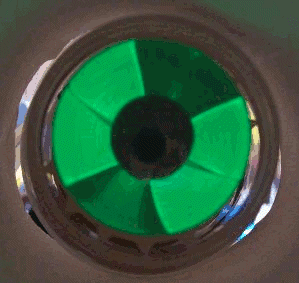

































 in the early 1930s, MOV developed the "catkin" type receiving tubes, vacuum tubes that had a true metal envelop as opposed to glass. They didn't quite catch on, so were only made for a few years. I have seen a pair or two for sale, MH4 that could be used in my other amplifier, but never went for it, they aren't exactly pretty HA! But I do wonder how they sound. This pair sold a few months ago, I resisted the urge to bid on them.
in the early 1930s, MOV developed the "catkin" type receiving tubes, vacuum tubes that had a true metal envelop as opposed to glass. They didn't quite catch on, so were only made for a few years. I have seen a pair or two for sale, MH4 that could be used in my other amplifier, but never went for it, they aren't exactly pretty HA! But I do wonder how they sound. This pair sold a few months ago, I resisted the urge to bid on them.






